Editor’s note: This text is an edited transcript of the webinar, Foundational Skills and Activities for Handwriting, presented by Dena Bishop, OTR/L.
Learning Outcomes
At the conclusion of this course, participants will be able to:
- Explain the importance of handwriting and the multiple motor and perceptual requirements for successful handwriting
- Identify six developmental grasp patterns and ways to change a non-functional grasp
- Describe how to create activities to support bilateral coordination, postural control, midline crossing, fine motor skills, visual perceptual skills, visual motor skills, letter and number recognition, motor memory, and language skills and attention
Introduction and Overview
Today, we're going to talk about foundational skills and activities for handwriting. This presentation is overflowing with activities that I hope that you can use in your classrooms, clinics or anywhere you work with young children. One objective for this course is to understand and be able to convey to others why handwriting is still so important in today's digital age. We will review multiple pre-writing requirements for functional handwriting. We will look at seven different perceptual categories and how they affect handwriting. After today's session, you should be able to create developmentally appropriate activities to work on pre-writing skills with children.
Why is Handwriting So Important?
More and more schools are issuing iPads to students and it seems like technology is taking over. I often get a lot of pushback from teachers and parents who ask, "If everyone is switching to typing, why do our children need to learn how to write correctly?" Here's why.
- Handwriting leads to stronger academic performance in both reading and math. This statement has been supported by multiple research studies (Dinehart, 2014).
- Handwriting boosts memory. If we write something down, we are more likely to remember it.
- Handwriting builds motor skills.
- Handwriting is part of our daily lives. No matter how much we use Siri, or communicate via text and typing, there is always a part of our day where handwriting is necessary.
- Handwriting increases focus.
- Handwriting stimulates creativity.
Handwriting and keyboarding are not the same skill. Handwriting requires more brain power than typing. Hopefully by the end of this seminar, you will all become advocates for handwriting, as learning to handwrite has long-lasting impacts.
What are Pre-Writing Skills?
Pre-writing skills are the fundamental skills required to hold a writing utensil, and to be able to write, color and copy. There are 11 different things that are required for handwriting:
- Postural control
- Gross motor skills
- Midline crossing
- Bilateral coordination skills
- Hand strength and control for fine motor activities
- Visual perceptual skills
- Visual motor skills
- Letter and number recognition
- Motor memory
- Language skills
- Ability to attend
We are going to go through each one of these requirements in detail. I'm also going to provide activities for each of these skills, so if you see a child struggling with any of them, you can implement an appropriate activity that will assist them.
Postural Control
Before fine motor can be achieved, a child needs to have a solid base of support. When you're thinking about the act of sitting, you need core strength for sitting upright, you need neck strength to keep your head upright. You need strong shoulders and arms for arm and wrist movements, and strong fingers for grasping that pencil and grasping objects. When a child sits in a chair, the proper seated position is in what's called a 90/90/90 posture. In other words, their hips are at a 90-degree angle, their knees are at a 90-degree angle, and their ankles are at a 90-degree angle. Their feet should be on the floor, or on a foot stool if they're too small. We never want a child dangling. When you see a child dangling in a chair, they often wrap their legs around the legs of the chair. That non-verbal body language is saying "I'm not secure in this chair, so I need to hold on with my legs because I'm afraid I might fall out of it." We also want the table to be just at or above elbow level. If the desk is up too high or too low, that's going to affect handwriting. We want the child to be comfortable and seated in a nice upright position.
If a child is not able to achieve good enough postural control, there are some activities we can use to help them. Tummy time for babies is essential for building postural control. If you are working with preschoolers, we still want to create those prone activities. We can have them lay on their stomachs, propped up on their elbows as they're playing during floor or play activities. Crawling is great for development of gross motor skills and postural control. We can encourage crawling through the use of obstacle courses or tunnels. You can do something called a "car wash" where you take PVC pipe and make them into frames. Then you hang strips of material or beads or whatever you want in it, and the children have to crawl through the carwash. Any kind of animal walk that requires you to have hands and feet or knees on the ground (e.g., the bear walk or crab walk) are great for building core strength. Playing on playground equipment is great for encouraging postural control, because it involves a combination of climbing, jumping and crawling activities. Some additional activities that involve jumping are using mini-trampoline, jumping into a ball pit or into pillows on the ground, or simply jumping off steps or ledges of some sort. Those are great activities that you can use for postural control.
Gross Motor Skills
There are some gross motor activities that will also support postural control. Yoga is a good example of a gross motor activity that is excellent for core strength. Super Stretch is an interactive yoga app for children (for Apple devices). The websites Yoga4Classrooms.com and CosmicKids.com are free and geared towards children. Other activities are great for postural control, such as rolling down a hill and exercise ball activities. Children can sit on the ball, bounce on it, or you can have them belly over the ball with their hands on the ground, reaching for things as you support them at the waist on the ball. Wheelbarrow walking would achieve a similar effect (the child walks with their arms while someone holds their legs). Pushing or pulling weighted objects is another idea. Tug of war is a great gross motor activity for postural control and building that core strength. Rough housing or wrestling can also be beneficial, as long as it is under proper supervision.
Midline Crossing
The midline is an imaginary line drawn from the head to the feet that separates the left and the right halves of the body. Midline crossing is crossing over from one side of the body to the other. This is a skill that a child should learn from infancy, but often children have a difficult time crossing midline.
How do you know if a child is having difficulty crossing midline? There are several telltale signs. First, you may see them switch hands during an activity, because they get stuck on one side of their body. Or, instead of transferring a toy to the other side, you might see them turn their entire body or move their whole trunk when reaching, to avoid having to switch midline. Another tipoff that a child is having trouble crossing midline is in their eye gaze. If you have a child follow an object with their eyes, they should demonstrate smooth and controlled movements from left to right or up and down. In a child who is having trouble crossing midline, you'll often see a little bounce in between right at midline. Their eyes have difficulty crossing from left to right or right to left. Another clear indication of difficulty with midline crossing is a child who writes or draws only on one side of the paper (usually their dominant side). They'll never write on the other side of the paper.
There are some fun activities that you can use to help promote and support midline crossing. You can encourage the use of big movements for drawing, such as painting on a large piece of paper or a whiteboard. The intent is to have the child use their entire arm across both sides of their body. You could implement flashlight tag, where you and the child each have a flashlight, and they have to match their flashlight with yours in a darker room. This encourages the child to move the flashlight across their body with one hand, without switching hands. You could have the child smear shaving cream or Cool Whip (or the messy medium of your choice) with one hand, and wipe it off using a towel in their other hand. Using tape, you could create a "road" on the floor. Have the child crawl along, pushing a car on the road, remembering to focus on turns, because turning is what's going to get them to cross over midline. Another idea is to have the child pick up objects on one side of their body and drop them into containers on the other side of the body. A great way to do this is to have the child sit at an angle on one hip, propped up on one elbow. Because they're propped on one elbow, they are not able to use that hand. This is an automatic, easy way to teach them to cross midline. If you want to increase the difficulty as you go through these activities, you can use tong and tweezers to do that in the same fashion, which works their fine motor skills as well.
Bilateral Coordination Skills
Another skill that is a prerequisite for handwriting is bilateral coordination. This is the ability to coordinate two parts of the body together for an activity (e.g., using both arms or hands together at the same time, or both legs at the same time, or coordinating legs and arms together). Doing jumping jacks or jumping rope are great bilateral gross motor activities. Also, cutting with scissors is a fine motor bilateral coordination activity. You're stabilizing with one hand and you're cutting with the other, using two hands together at the same time. This is essential because this builds upon midline crossing. If a child does not have the ability to cross midline, they are going to have a hard time with bilateral coordination skills.
There are several great examples of activities that encourage gross motor bilateral coordination. Again, use those animal walks (e.g., bear, crab, dog, duck). Not only will they help to develop postural control, but they will also help develop coordination activities. Be creative and let the children choose the animal they want to imitate. Crawling is a great reciprocal activity, using arms and hands together, resulting in better bilateral coordination. Any kind of foot hopping or jumping patterns are useful (e.g., jumping on one foot and then the other, hopscotch, skipping, galloping). Riding a tricycle is a great activity to encourage gross motor bilateral coordination. Although contrary to most playground etiquette, crawling up a slide is an activity similar to climbing up a ladder. It is a skill where the child must use that reciprocal motion. I have even tied a bunch of tube socks together to make a rope, and tied the rope to the top of the slide, so that the child has to climb up using that rope instead of the sides of the slide.
Additionally, there are many fine motor bilateral coordination activities. For example, have the child use stencils, where they have to hold the stencil with one hand and trace with the other. Again, cutting with scissors is a good activity, as is building with Lego blocks or playing with Mr. Potato Head. Other bilateral coordination activities that involve fine motor skills include using a hammer and nails, lacing cards, and Play-Doh activities. Even the act of tearing paper can be useful. Instead of coloring with crayons, you can have the child tear up colored paper and glue the pieces onto that area that they want to color.
Hand Strength/Control for Fine Motor Activities
A child's hand is not fully developed until the age of seven. When we're asking our preschoolers to write, we have to keep that in mind. Hand preference can be observed early on, but actual hand dominance doesn't normally come into play until about the age of six. Also, it is important for us to encourage children to use both hands, especially in preschool or early intervention, to develop dexterity and control with both hands, not just their preferred hand. The arches in the palm of the hand aid with grip strength and dexterity.
Separation of the two sides of the hand is essential for proper handwriting. Think of it as drawing a line to section off the forefinger and the thumb from the rest of the hand. Oftentimes, you'll see children who don't have that separation of the two sides of the hand, and their whole hand works together. Over time, that can cause weak hand stability, ultimately leading to an improper pencil grasp. By training your eye to look for certain things like the arches of the hand, dimples, muscles tone, and dexterity, you can tell if a child's hand is stable for writing and if they have enough hand stability.
Look at the child's hands in Figure 1. You can see that there's a nice bowl in the center of each palm -- those are the arches of the hand. You develop those arches in your hands from weight bearing activities, from crawling as an infant and a toddler. You want to see a nice, rounded definition in their hands, nice arches in the hands. A lot of times, preschoolers will have little dimples on their knuckles, because their hands aren't fully developed until the age of seven. However, in kindergarten and first grade, if a child still has some of those dimples on their knuckles, that is an indication of low muscle tone in their hands, which makes for weak hands.
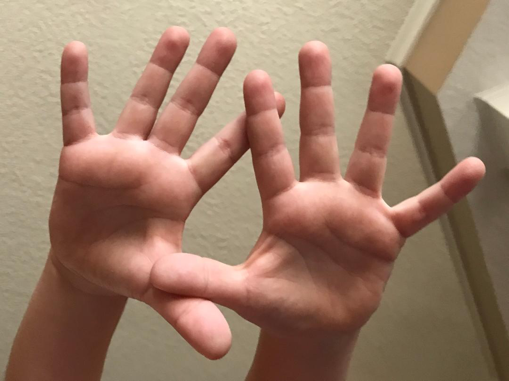
Figure 1. Hand arches.
There are a number of things you can observe that will indicate whether a child has good hand stability and dexterity. Can they touch each finger to their thumb? With their fingers, can they show you number one, number two, number three, number four, number five? Are they separating the two sides of the hands? Those are the things that you can look for.
Grasp patterns. As a child grows and develops, their grasp patterns change over time.
Palmar Grasp (4-6 months): Infants who are just learning to pick things up use the palmar grasp (Figure 2). This is also known as a raking grasp, where they rake the object into the palm of the hand.
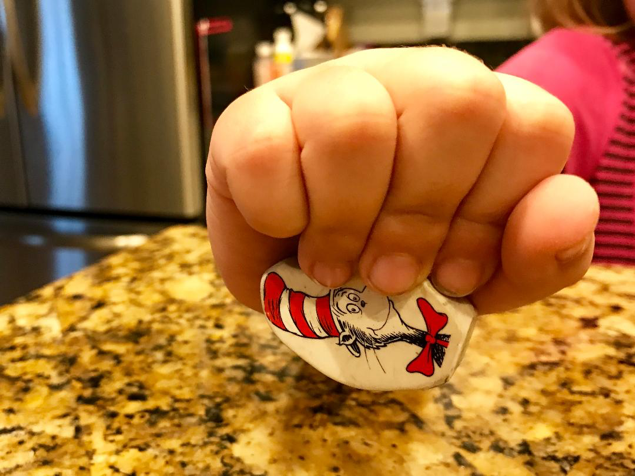
Figure 2. Palmar grasp.
Pincer Grasp (9-10 months): Once children get a little bit older and begin to finger-feed, you will start to see a pincer grasp develop (Figure 3). Ideally, what you want to see is a nice little circular opening in that grasp, as if you could slide a pencil right in there. Learning the pincer grasp is essential, because it is a precursor for a tripod grasp for handwriting.

Figure 3. Pincer grasp.
Palmar Supinate Grasp (9-12 months): When a child first begins to pick up a pencil, normally what you'll see is a palmar supinate grasp (Figure 4). They do this by using their palm of their hand to hold the pencil, in such a way that they have no finger stability. When a child holds the pencil with the palmar supinate grasp, it is likely that they're using their entire arm to move the pencil, with possibly some wrist movements.
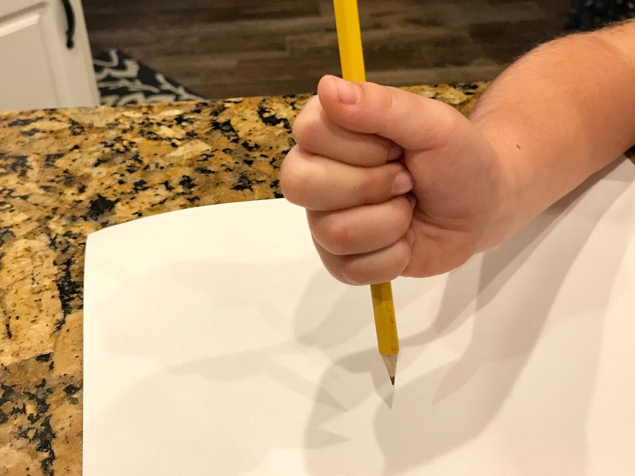
Figure 4. Palmer supinate grasp.
Digital Pronate Grasp (12-15 months): At about one to one-and-a-half years of age, you'll start to see a digital pronate grasp (Figure 5). This is where children begin to move the pencil into their fingers, but you'll notice that it's done in kind of a backwards, upside down posture. Developmentally, this is completely okay; we don't need to intervene if the child is at the 12- to 15-month level. Toward the age of two, you might still see that digital pronate grasp, and even begin to see a tripod grasp.
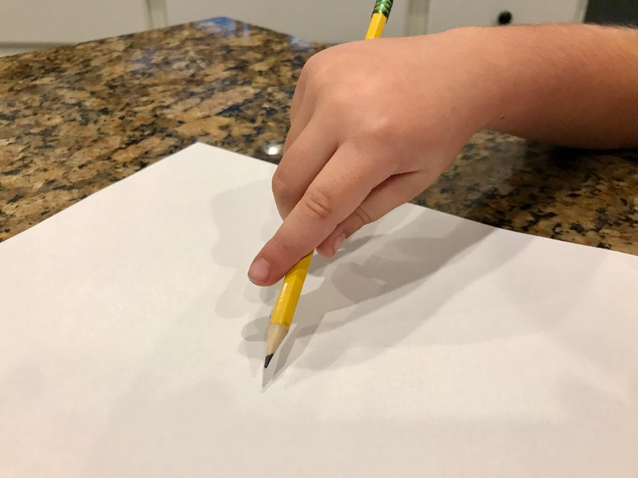
Figure 5. Digital pronate grasp.
Quadrupod Grasp (3-4 years): By three to four years of age, you're going to want to see all fingers in on the pencil in a supinated (i.e., wrist up) grasp, as opposed to a pronated grasp (i.e., wrist and thumb pointed downwards, elbow out). At three to four years, you'll start to see those fingers attach to the pencil (Figure 6). They're no longer using the palm of their hand, but their fingers to write.
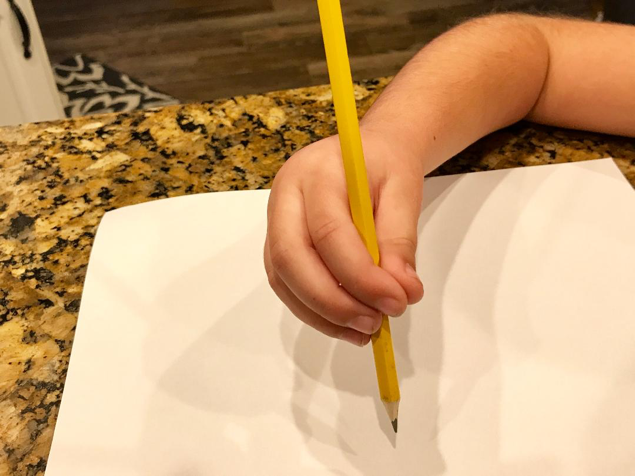
Figure 6. Quadrupod grasp.
Tripod Grasp (4-5 years): It's not until around kindergarten where you're going to see a nice tripod grasp develop (Figure 7). Now, if you have a child who is four or five years old and they're still back at the palmar supinate grasp, there are some things that you can do to help with that.
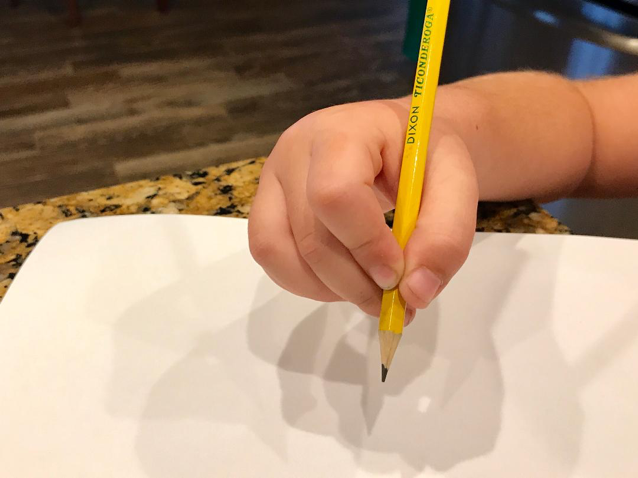
Figure 7. Tripod grasp.
Fine motor activities. Play-Doh and clay activities are great to help a child develop a proper pencil grasp, because they develop hand strength and control. Playing with clay is a resistive type of activity to build that strength. Clothespin clipping activities use bilateral coordination. If a child is clipping clothespins onto a ruler, for example, they have to clip the clothespin one with one hand, and hold the ruler with the other hand. You could have a child use a single hole punch to punch holes in paper. This will be a little bit more challenging if the child has weak hands. It takes quite a bit of strength to squeeze those hole punches. If the child is not able to do that, you could employ squeaky squeeze toys, such as dog toys. If the child is able to squeak it, it's very motivating for them to hear the sound. You can use bath or pool toys that fill up with water, and when you squeeze them, water shoots out. Children love those. You could use squirt bottles, such as those used to water plants or wash windows. Legos or Duplos (large sized Legos for preschoolers) are also useful and build fine motor strength. Activities using tweezers, tongs or eye droppers strengthen those handwriting muscles. Cutting different textures with scissors is a fun activity. Be creative and use unusual materials such as Play-Doh, cardstock, aluminum foil, straws -- whatever you can think of. The children will love being able to cut through different materials instead of just paper. String beads or cereal onto string or pipe cleaners. If you use beads that have different colors or numbers/letters, the children can work on patterning or sequencing at the same time that they are gaining manual dexterity. Finger puppets are also great for dexterity because you're using fingers and separating the two sides of the hand. There are plenty of games that encourage fine motor skills, such as pick up sticks or card games like Go Fish. Many times, I've worked with little children who find it so hard to take only one card from the deck because of poor fine motor skills. A child's work is play. If we encourage fun and playful activities to build those fine motor skills for pre-writing, they're not even going to realize that they're "working."
Progression of pre-writing strokes. When a child learns to write, they will start with shapes or lines first. Once a child can successfully master each one of the following strokes/shapes, they can create any letter of the alphabet. Next to each stroke/shape, you can see the age at which a child will usually be able to imitate it, and also the age at which they can copy or master that stroke.
- Vertical Line: Age 2 imitates; age 3 copies/masters
- Horizontal Line: Age 2½ imitates; age 3 copies/masters
- Circle Shape: Age 2½ imitates; age 3 copies/masters
- Cross Shape (+): Age 3½ imitates; age 4 copies/masters
- Square Shape: Age 4
- Right/Left Diagonal/Slanted Line: Age 4½
- X Shape: Age 5
- Triangle: Age 5
It is important to note that if you have a child who is having difficulty with these diagonal lines, and the child's name is Kevin, for example, that child is going to have a hard time being able to write their name. The K, the V and the N all have diagonal lines. If you want start working on Xs and triangles, this will help them to develop those diagonal lines for writing those letters.
Achieving a functional grasp. There are a few things that you can do to help promote a functional grasp. First, we need to work on separating the sides of the hand. If you place a pompom or a bead in the last three fingers of the child's hand, and have the child hold that, then put the pencil in their hand, you now have a tripod grasp, because they're able to stabilize by holding that pompom right in their hand.
Another thing I've discovered involves using a hair scrunchie and a smaller rubber band (Figure 8). You slide the scrunchie over the top of the child's hand onto their wrist. Then, you put the end of the pencil through the smaller rubber band, and place the pencil in the child's hand. The smaller rubber band pulls the pencil into a correct position in the hand. Sometimes, I will also attach a bead to a string and tie it on the scrunchie. If you place the bead in the last three fingers of the child's hand, you've now created a pencil grasp that's functional for the child. I like using this for children who hold the pencil way out in their fingertips. If you use the scrunchie on the wrist, the smaller rubber band automatically pulls the pencil into that proper web space (between the index finger and the thumb) for writing.
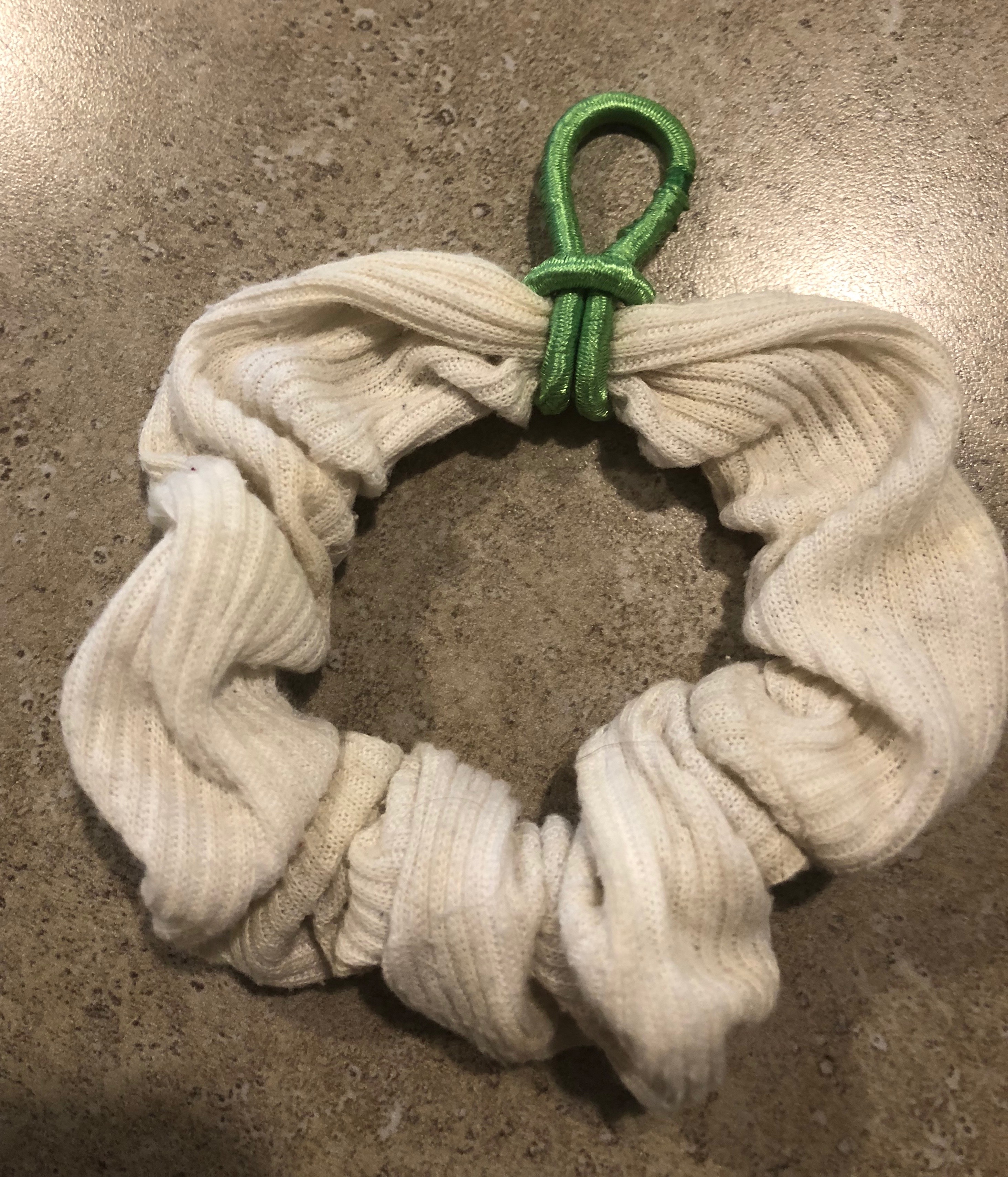
Figure 8. DIY handwriting aid.
Another technique you can employ is using small broken crayons to promote a tripod grasp. I will even take a golf pencil and sharpen it down to an inch. There's no other way of holding a pencil or a crayon that short: you cannot use a palmer grasp; you cannot use a digital pronate grasp. It essentially forces the child to use a tripod grasp. Handwriting Without Tears sells Get Set for School flip crayons. Each crayon has two colors, one on each end. If the child is coloring with one end that is red, they must flip the crayon over to use the green, for example. It requires great in-hand fine motor manipulation skills. Again, these crayons are small, so the child must use a tripod grasp or a quadrupod grasp. Handwriting Without Tears also sells golf-sized pencils for little hands, which include built-in erasers.
Additionally, you can use a slant board to promote a proper wrist position. A slant board is just an angled piece of plastic that you can buy. If you don't want to purchase a slant board, you can use a three-inch ring binder. You place the binder rings away from the child, and it slants down towards the child on the desk. That's going to bring the paper up at an angle to the child so that the wrist position is better. This is for a child who may be writing with the arm and elbow up off the table. You can use a slant board to help have them rest and support their arm as they're writing. If a slanted desk surface doesn't work, you can have the child hold the paper up to a vertical surface, such as a wall. They would hold the paper on the wall with one hand and write with the other hand. This is great for promoting bilateral coordination skills as well.
I know a lot of teachers like pencil grasps. I tend to like them for certain students. If the student truly wants to change their pencil grasp because they're having pain in their hand, they're more motivated to use them. However, after the novelty wears off, the child will typically use their improper pencil grasp over the top of the pencil grasp, and it does not serve the intended purpose. I see that often, within two weeks, the child figures out how to not use that pencil grasp and work around it, even though it's still on the pencil.
One of the things that I recommend to all my kindergarten teachers and preschool teachers is the Twist 'n Write pencil (Figure 9). They are readily available online. Your forefinger goes through the opening at the top. There's a little indentation in the front that supports your forefinger, resulting in a proper tripod grasp. There are built-in erasers on each side. When you twist the top, the lead comes out. I recommend these even before I go to pencil grasps. The children find them very comfortable as well.
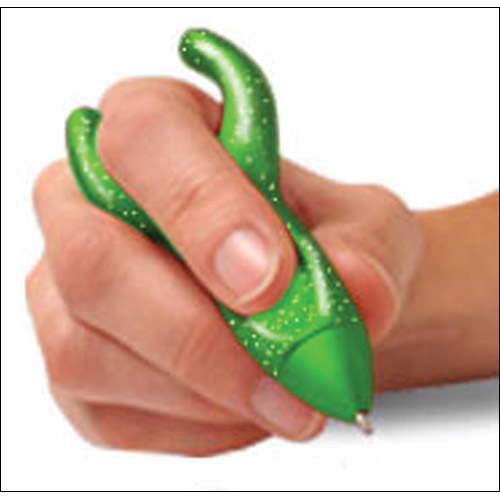
Figure 9. Twist 'n Write pencil.
Activities to encourage handedness. Hand preference starts at an early age, but hand dominance does not develop until the age of six. I wouldn't push a three-year-old child to choose a hand. I'd start looking at handedness at about five, six, seven years old. However, if you have a child who isn't showing any signs of hand preference, there several activities that you can do to try to encourage the child to use one hand or the other.
- Screwing lids on and off jars (one hand supports, the other hand is doing the work)
- Large Legos (Duplos)
- Pushing cars or trains on a track
- Tool use: hammers, markers, scissors (anything that requires using one hand; promote tool use in the hand that is most successful)
- Scooping beads, rice, or sand with spoon
- Pick-up games with pennies, beans, toothpicks
- Bowling and ball play (small balls that you throw and catch)
- Encourage coloring on small pieces of paper (the size of half of an index card); they have to hold the paper with one hand and color with the other.
Visual Perceptual Skills
In some cases, children have difficulty with handwriting for reasons that are not motor related. It may be that they have deficits in their visual perceptual skills, or the brain's ability to make sense of what the eyes see. It is important for everyday activities such as dressing, eating, writing, and playing. There are seven different categories for visual perceptual skills. We will review each of these categories, as well as some visual perceptual activities that are helpful for children.
Visual spatial relations. Visual spatial relations is the ability to determine one form or part of a form that is turned in a different direction than the others. This is why some of our children have such a hard time recognizing b and d or p and q. They don't understand that just because it's rotated, it's a different letter. They also have difficulty differentiating between in and out, over and under, and left and right, because those are a spatial skills concepts.
Sequential memory. Sequential memory is the ability to remember a series of forms and find it among other forms. If your child is having a hard time sequencing the alphabet, or copying from one place to another, this may be a problem with sequential memory. Sometimes, even with older elementary children, when they're copying sentences off the board, they will skip words. Or, when a child is copying sentences, they're copying one letter at a time. They're not seeing it as a whole word that they can write, but just each individual letter. This is a sequential memory problem.
Visual discrimination. Visual discrimination is the ability to differentiate between objects and forms. This includes skills like being able to identify money and sort coins or other objects. If they're not able to discriminate the differences between or the similarities between objects or pictures, they're going to have a difficult time differentiating between n and m, b and d, and p and q.
Form constancy. Form constancy is the ability to see a form and find it among other forms, although it is sized differently or rotated. Again, this is going to be a reason why some children will have trouble recognizing letters and numbers (e.g., recognizing that 6 and 9 are two different numbers).
Visual memory. This is a little different than visual sequential memory. Visual memory is the ability to store visual details in short-term memory, such as recalling a phone number. Reading comprehension is going to be affected when visual memory is deficient. Think about showing a photograph to someone, and then taking it away and asking them questions about it. A child who has problems with visual memory will have difficulty remembering facts about the picture.
Visual closure. Visual closure is the ability to fill in the missing details into an incomplete shape. This requires abstract problem solving. A good example of this is working on puzzles; being able to put a picture together in your mind and to piece it together correctly. This also will cause a problem with writing and spelling. With spelling, a child with visual closure deficits won't know the ends of the word or the middle of the word. For writing, a child with visual closure deficits will not be able to know if a word is complete.
Visual figure ground. This is the ability to perceive a form and find it hidden in a conglomerated ground of matter. For example, asking a child to find the blue crayon in their pencil box. Visual figure ground is being able to filter out all the other crayons to look for that blue crayon. The adult equivalent of using visual figure ground skills would be when we are rummaging through our junk drawer to find something we need. Hidden picture activities are useful for children to work on their visual figure ground skills (e.g., Highlights books or Where's Waldo books).
Some examples of activities to encourage visual perceptual include:
- Paper mazes and marble mazes
- Connect the dot activities
- Hidden pictures
- Puzzles
- Copying pictures or forms. You can start with various simple shapes, just copying, and then interlock shapes together on paper and have them copy that as well.
- Wooden blocks
- Patterning
- Matching and sorting
Visual Motor Skills
Visual motor skills are another prerequisite for handwriting. This involves eye-hand coordination, or the ability to use the hands and eyes together in a coordinated manner. The coordination of visual information is perceived and processed with fine and gross motor skills. How do you know if a child is having difficulty with visual motor skills? One clue is that they might not be very athletic. They may be clumsy, tripping and falling all the time. They're going to have a hard time catching and kicking balls. They may also exhibit difficulty with recognizing patterns, have a hard time drawing or copying shapes, and have trouble with sequencing and piecing together a puzzle.
One activity that you can use to encourage visual motor skills is catching and tossing a ball. Another idea is to have the child sort shapes into a shape sorter or put coins into bank slots. You could have the child play with a ring toss or bean bag toss. Have them put beads onto a vertical dowel. Get a clump of Play-Doh, put it on the table, and stick a wooden skewer or chop stick into it. You can use fruit loops or beads, and you can pattern or color match and drop these beads or cereal pieces onto these vertical dowel rods. Another fun activity is to play balloon volley, either with your hands or using "rackets" fashioned from paper plates and tongue depressors or rulers. Stacking blocks or pegboard activities are great visual motor activities, as is cutting with scissors, or using bingo dot markers for coloring. Commonly, children who have visual motor skill deficits struggle with dressing activities, such as buttoning, zippering and tying shoes. Clothing fasteners are another great visual motor activity, as are weaving or lacing cards.
Letter and Number Recognition
We talked about motor skills and perceptual skills, but if a child doesn't have the ability to recognize letters and numbers, they are going to have handwriting issues. One activity that you can implement for letter recognition is matching letters using beans and cupcake wrappers. Get a cupcake tin and put cupcake wrappers in it. Then, put letters on the inside bottom of the cupcake wrappers and have beans with the letters on them. The goal is to have the child match the beans with the cupcake wrappers. You can also use clothespins and paper plates or papers, where you're matching letters. You can cut out letters from magazines and glue them to paper. Have one paper just for As, one for Bs, and so on. That will help with letter recognition.
For number recognition, you can use a cup tower. Take Styrofoam cups and write a number sequence on the lip of each of the cups. The goal is to have the child stack them in the correct sequence. Another idea is to use a hole punch, write numbers on index cards, and have the child punch the correct number of holes into the corresponding card. Additionally, you could use cotton balls or pompoms and cards -- anything where you have a number written on a paper/card, and have the child put the correct number of pompoms or cotton balls on that number card. You could use M&Ms if that motivates your child. Pinterest is a great resource for ideas and activities for letter and number recognition, fine motor and visual motor activities for preschoolers. You can even Google "letter recognition activities for preschoolers" and dozens of activities will result.
Motor Memory
Motor memory is a little bit different than letter recognition. It is the process of acquiring a skill through practice, and it is a durable kind of memory. Things like riding a bike, playing piano, tying shoes, typing, writing letters and numbers: once you learn it, you don't really have to think about it anymore. I've had many children over the years with motor memory issues. For example, they're so focused on writing each letter of a word, that they're not comprehending the word that they're writing. Oftentimes, their words won't make a lot of sense because they're so focused on each letter.
One activity to support motor memory is to draw letters on the child's back. You can have the parents do it at home. This is a great bed time activity when the child is laying there, because it's nice and calming and soothing. You can write a letter on their back and have the child identify that letter or number. They're having to focus on the shape of the letter to understand what that is. You can also use flashlights or laser pointers to write on the wall. Again, you're not seeing the strokes, but you're seeing it in your head, and that's what you want to accomplish with these motor memory activities. Draw letters using substances such as shaving cream, sand, salt or gel. Again, get creative with that medium. The idea is to use other sensory pathways in the brain (e.g., touch and smell) to recreate that motor memory. Another way of doing this is writing letters and numbers with your eyes occluded. You can hold up a file folder and block the paper as the child's doing it. Or, you put magnetic letters into a bag and ask the child to choose a letter and by touch, try to name the letter that's in their hand. Great activities to develop motor memory for letters and number recognition.
Receptive Language Skills
Another area that is a prerequisite for handwriting is receptive language skills. There are a lot of prepositional words that we use when we are teaching a child to handwrite. Words such as:
- Top/bottom
- Near/far
- Big/little
- Over/under
- In/out
When teaching handwriting, we use sentences like:
- "Start at the top of the page."
- "Write a big letter A."
- "Color near the edge of the paper."
- "Draw a line under the letter C."
If a child doesn't understand what these prepositional words mean, it may be because they don't understand visual spatial relations, because they don't have those receptive language skills. This will impact their ability to learn handwriting.
You might want to role play with these words using objects. For example, using a ball and a bucket, you can ask the child to put the ball in the bucket, or to put the ball over the bucket, near the bucket, at the bottom of the bucket, or the top of the bucket. We have to also understand that when we talk about top and bottom, young children think of the top as being the top of their head, and the bottom as being at their feet. When we lay a piece of paper down horizontally on the desk, and we ask the child to draw at the bottom of the paper, they may think that the bottom means that they need to flip the paper over. If they don't have a grasp of those spatial concepts, they will have difficulty with handwriting.
Other activities that help build receptive language skills include:
- Any type of worksheets. You can find lots of worksheets online to work on specific words. For example, if you want to practice using the word "under," there are worksheets that show three pictures, and the child needs to select the picture that supports the word "under."
- Singing songs like the Bear Hunt, where we work on prepositional words in a gross motor way (the lyrics are "you can't go over it, you can't go under it, you can't go around it, you gotta go through it").
- Asking the child to draw what they hear. You can verbally instruct them to start at the top of the paper and draw a big line down to the bottom of the paper, or tell them to draw a circle in the middle of the paper.
If you have access to a speech language pathologist, they would be able to give you a lot more ideas for receptive language skill activities.
Ability to Attend
When I'm called into a classroom for a handwriting evaluation, within 30 seconds, I can tell that the child doesn't necessarily have a handwriting issue, but more of an attention issue. If they're not able to sit and attend to a tabletop activity, they're not going to be able to attend to the fine motor details and the fine visual discrimination details between each letter or words.
As a general rule, a child should be able to focus on a non-preferred activity for as many minutes as their age. If you're working with a three-year-old, a non-preferred activity minimum should be three minutes. If it's a preferred activity, you're going to get a longer focus and attention, because the child is motivated by that activity. However, you know a child is not ready for handwriting instruction if he or she cannot stay within a certain play area in the room for a certain period of time, or if they're not able to sit at a desk or a table for any length of time. Additionally, they should be able to complete simple clean up tasks independently.
Some activities and strategies you can use to work on attention, before even considering handwriting instruction, include:
- Quiet bins or task boxes (where you have one activity in a box, and they need to complete that activity before they can move on)
- Sensory play or tactile play (e.g., rice, dry beans in bins; letters or numbers in bins that the child pulls out and matches into a puzzle)
- Repetitive tasks such as coloring or putting objects into a container (repetitive tasks build attention)
- Add music to a task (additional sensory feedback increases motivation and attention)
Some behavioral strategies that you can use to help with activities or to build attention would be:
- Give one-on-one attention and gradually fade. You'll have better attention when you're working with that child one on one. Then, gradually back yourself away from that child so that they're able to independently sit and complete that activity on their own without you having to be right next to them.
- Use of timers and visual schedules to stretch the time. For example, you can tell them "You have 3 minutes to finish coloring, and when the timer beeps, then we're all done with coloring and we can move on to the next activity."
- First/Then behavioral approach. "First, we need to do a worksheet (non-preferred activity); then you get a preferred activity as a reward for completing it." Having that schedule of first/then oftentimes helps to build that attention and focus.
Pre-Handwriting Programs
Once we realize that our child is ready to learn handwriting skills, there are some pre-handwriting programs that are extremely beneficial. These are the three main programs that I have seen with a preschool/early intervention focus:
- Handwriting Without Tears (lwtears.com): This program was designed by an occupational therapist whose child who cried every time he had to write. She developed the Handwriting Without Tears curriculum and devised strategies to allow her son to better his handwriting ability. It involves multisensory and developmental instruction. They offer a Pre-K program called Get Set for School, and the Handwriting Without Tears program is for children in grades K-5.
- Zaner Bloser (zaner-bloser.com). They also have a preschool program, and a box kit that has manipulatives, such as beads, links and all kinds of different fine motor activities that are done in conjunction with the work program that they have.
- Universal Handwriting (upub.net): Universal Publishing has materials and resources to help students develop fluent and functional handwriting. They offer handwriting programs, language arts journals and workbooks, math and science journals, and a variety of resources for educators.
Included with your handouts, I have attached a worksheet titled "20 Ways to Learn Letters & Alphabet Sequence Without Holding a Pencil." Hopefully after taking this course, you will use some of these new techniques to get creative in ways to motivate your child, especially if they are struggling with handwriting.
References
Dinehart, L.H. (2014). Handwriting in early childhood education: Current research and future implications. Journal of Early Childhood Literacy, 15, 97-118. doi:10.1177/1468798414522825
Citation
Bishop, D. (2018). Foundational skills and activities for handwriting. continued.com - Early Childhood Education, Article 22766. Retrieved from www.continued.com/early-
